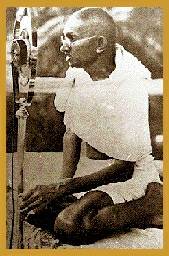|
PinkMonkey Online Study Guide-World History
16.2 Emergence of India as a Nation
India’s national movement can be divided
into three phases. During the first phase, from 1885 to 1905,
the Indian National Congress was dominated by the moderates.
In the second phase, from 1906 to 1919, the extremists emerged.
During the third phase from 1920 1947, Mohandas Karamchand Gandhi,
played the leading role. Gandhiji, fondly called "Mahatma"
by the masses, was foremost figure in the freedom movement. He shock
the British Empire by his non-violent, non-co-operation, soft satyagraha,
boycott of British goods and ’Swadeshi’ campaign.
The British East India
Company, a foreign trading organization established an empire
in India. During the 18th
and the 19th
centuries, the Indian princes were not united at all. Thus the Indians
were no match to the well-armed imperialists of the West. During
the 19th
century, there was great discontent against foreign rule. A revolt
took place in 1857, owing to a number of important factors: Lord
Dalhousie’s autocratic methods; his annexations according
to the Doctrine of Lapse; the rise of disgruntled Indian
elements also suffered in the British regime by way of loss of titles
or pensions; the introduction of certain reforms in the army in
general and of greased cartridges in particular. After this, the
Company’s rule ended in India and India was handed over to the British
crown. By the Indian Councils’ Act of 1861, a few concessions
were given to the Indians in the field of government. However this
did not satisfy anybody.
The Indian National Congress was established
in 1885 during the vice-royalty of Lord Dufferin. In 1892
another Indian Council’s Act was passed, which proved disappointing.
In the early days, the Congress was not a representative of the
masses. It was dominated by Indians educated in English, who believed
that the British would guide the country towards self-government.
Later, the Congress was split into two groups; the moderates
led by Gopal Krishna Gokhale and the extremists,
who found a great champion in Bal Gangadhar Tilak. The latter
of these earned the title of ’Lokamanya’ owing to his patriotism
and self-sacrifice. The Morley-Minto Reforms of 1909 gave
very little to India. Tilak, who was referred to, as the
’Father of Indian Unrest’, electrified the people by his
slogan "Swaraj is our birth right." Tilak, along
with two other great national heroes Lala Lajpat Rai, and Bipin
Chandra Pal, strengthened the national movement and prepared the
ground for the unique work of Mahatma Gandhi.
Inspite of India’s help to Great Britain during
World War I ( 1914 1918), the Montagu-Chelmsford Reforms (1919),
introducing dyarchy in the provinces, was a great disappointment
to India. The faith of Indians in Great Britain was shaken by the
Rouwlatt Bill, the Jallianwala Bagh massacre and the
repressive methods adopted by the British government.
 Exhibit 16.1
Exhibit 16.1
Mahatma Gandhi created history by launching
his Satyagraha Movement. The British ’Raj’ in India was shaken
by the non-co-operation movement that was also non-violent in nature.
In 1927, the Indian National Congress fixed ’Purna Swaraj’
as its goal. As a result of the three Round Table conferences (held
in 1920, 1931 and 1932), the government of India Act of 1935
was passed. According to this act, India was to have an all-India
federation. The Act was put into effect in 1937. Complete provincial
autonomy was introduced. The Congress was able to form ministries
in 6 out of 11 provinces. Thus 1937 was a landmark in India’s political
and constitutional history. The people could have their own ministers
and dyarchy was abolished. However, when the Second World War broke
out in 1939, the Congress ministers resigned, as India was
forced to join the war without her consent.
[next page]
|
Index
16.0 Introduction
16.1 - The Causes Of The Rise Of Nationalism
In Asia
16.2 - Emergence Of India As A Nation
16.3 - Rise Of Modern China
16.4 - Rise Of Modern Japan
16.5 - National Awakening In South East Asia
16.6 - National Awakening In Arab Lands
16.7 - Israel
16.8 - African Nationalism
16.9 - Nationalism In Latin America
16.10 - Dates & Events
Chapter 17
|